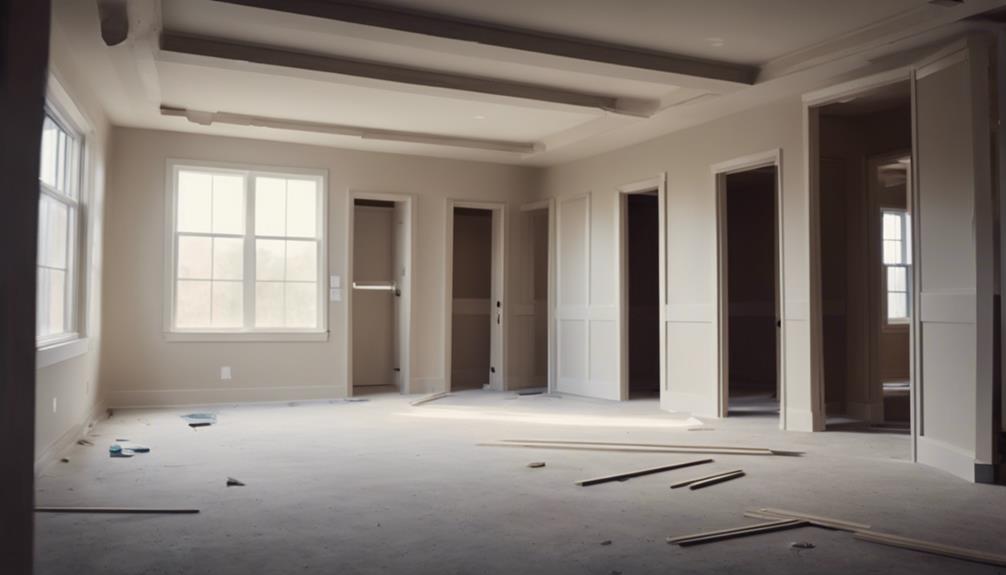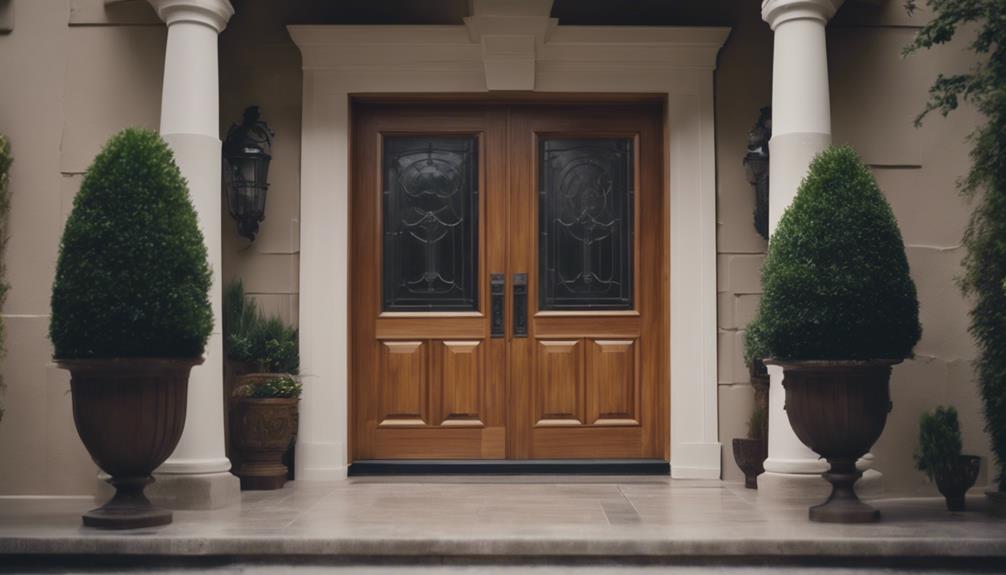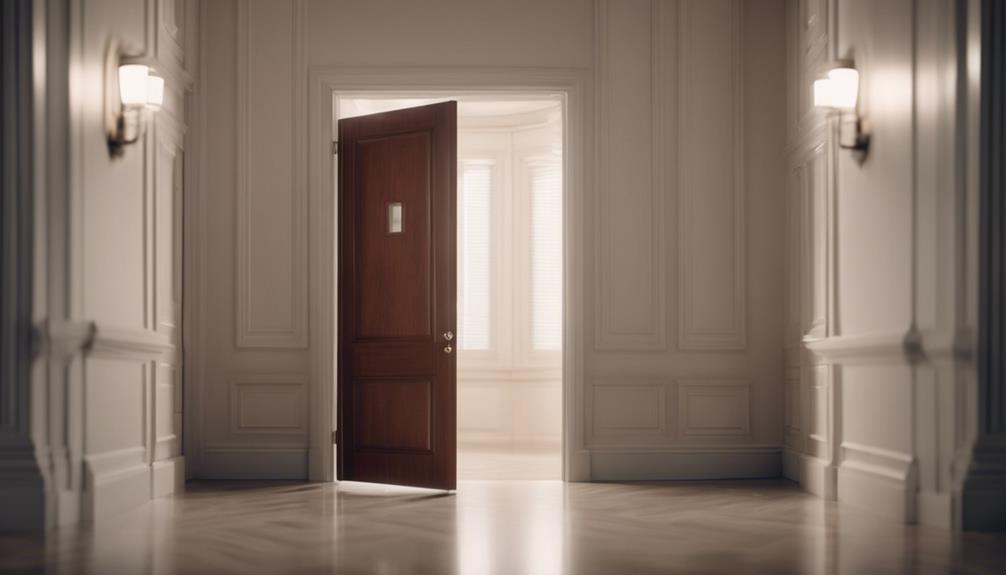Installing interior doors before sheetrock is a smart move. By placing them early, you shield them from damage and guarantee they fit perfectly with the finished walls. This process not only simplifies construction but also safeguards the doors during the final touches. Plus, it sets the stage for a cleaner and more efficient building experience. Want to learn more about why this order matters for your project's success? Discover how early door installation can prevent damage, ensure precise alignment, and create a stable foundation for the finishing touches.
Key Takeaways
- Installing doors before sheetrock protects them from damage.
- Early door installation ensures precise alignment with finished walls.
- Easy Hang brackets simplify door installation process.
- Verify squareness and levelness of door frame before installation.
- Maintain appropriate clearances for smooth door operation.
Importance of Installing Doors Before Sheetrock
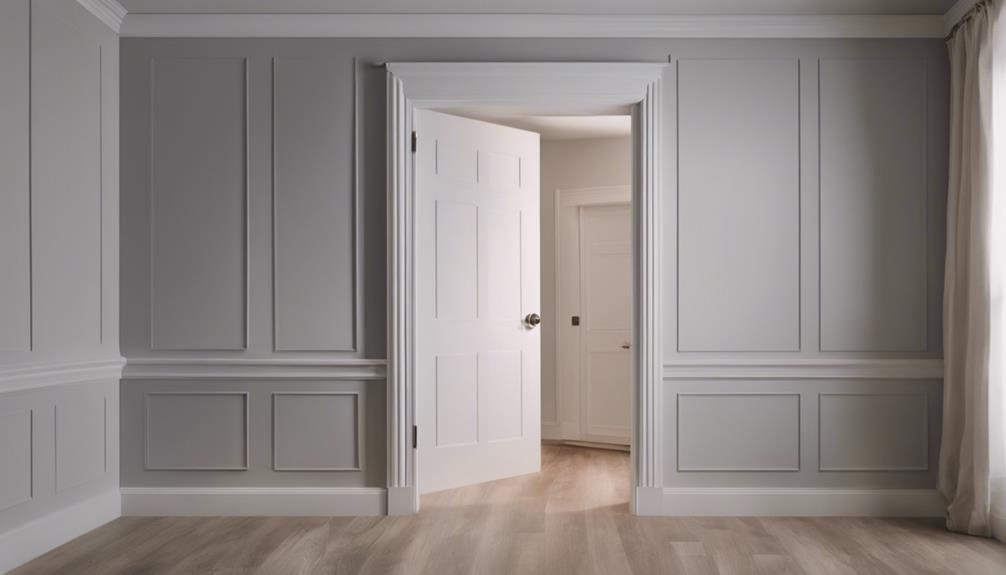
Installing doors before sheetrock is vital for protecting the doors from damage and ensuring smooth alignment with the finished edges of the sheetrock. When you install the door frames before the drywall goes up, it makes the process much easier.
Dust, mud, and debris from the sheetrock work can potentially harm the doors if they're put in after. By having the doors in place early on, the plastering and finishing work becomes a breeze. This method not only safeguards your doors but also helps in achieving a cleaner and more efficient construction process.
The precise fitting of the door frames against the sheetrock edges is important for a polished and professional look in your home. So, remember, when it comes to construction, getting the doors installed before the sheetrock is a smart move that ensures your doors stay intact and perfectly aligned with the finished walls.
Benefits of Early Door Installation
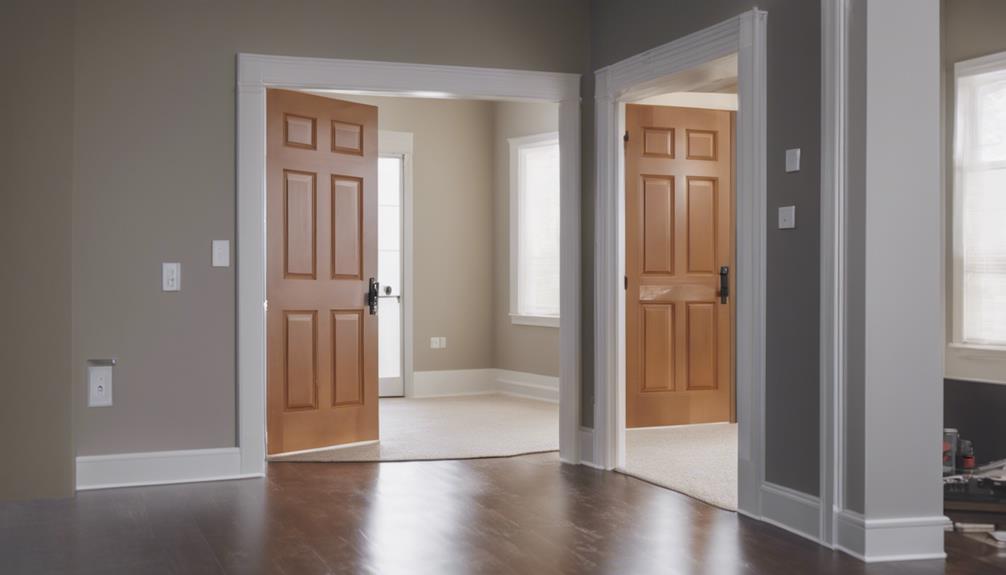
Starting door installation early offers the advantage of protecting your doors from potential damage and ensuring a seamless alignment with the finished walls. When interior doors are installed before drywall, it sets a solid foundation for a successful finishing process.
Here are some benefits of early door installation:
- Damage Prevention: By installing doors before finishing the drywall, you shield the doors from harm during the construction phase.
- Precise Alignment: Early installation allows for accurate alignment with the finished wall surface, resulting in a polished and professional look.
- Simplified Door Hanging: Having the doors in place early provides a stable frame for easier and more straightforward door installation.
- Moisture Prevention: Installing doors before drywall can help prevent potential warping or movement of the door frame due to moisture, ensuring long-term durability.
Easy Hang Bracket Installation Process
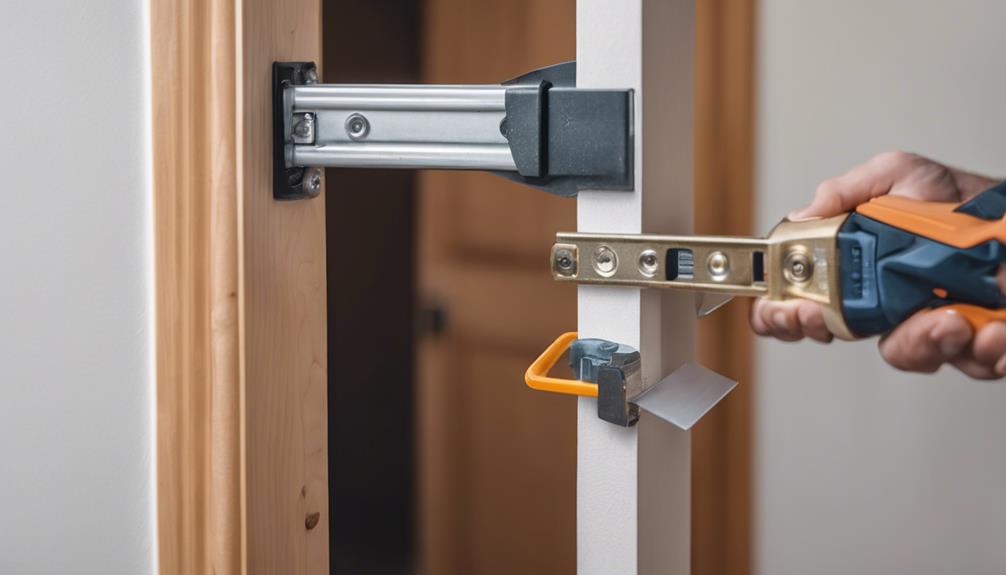
To streamline the installation process, consider incorporating Easy Hang brackets for precise alignment of your interior doors. These brackets are specifically designed to guarantee consistent results for both drywall and non-drywall installations, making them versatile for various types of projects.
When using Easy Hang brackets, it's crucial to follow the specific placement instructions to achieve ideal bracket positioning. The adjustment screws provided with the brackets allow for fine-tuning the positions, enabling you to achieve a perfect fit for your door.
The Easy Hang system simplifies the door installation process, making it hassle-free and ensuring that your doors are aligned correctly. By utilizing Easy Hang brackets, you can save time and effort while achieving professional results.
Whether you're a seasoned DIY enthusiast or a beginner in home improvement projects, Easy Hang brackets can make the installation of interior doors much more manageable and efficient, providing a straightforward solution for your door installation needs.
Achieving Flawless Door Alignment
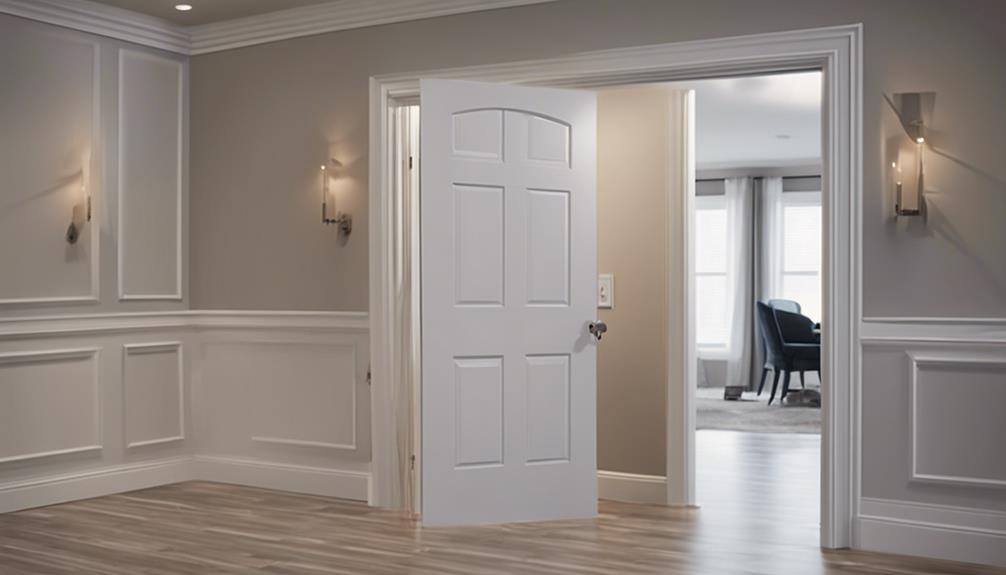
For precise and flawless alignment of your interior doors, prioritize meticulous attention to detail during the installation process. Here are some key steps to help you achieve flawless door alignment:
- Check the Frame: Verify the door frame is square and level before installation to prevent any alignment issues.
- Use Shims: Place shims behind the hinges to adjust the door's position within the frame, guaranteeing a perfect fit.
- Secure Hinges: Double-check that the hinges are properly installed and tightened to keep the door in place.
- Test the Swing: Before finishing the installation, test the door swing to guarantee it moves smoothly and without any obstructions.
Setting Clearances for Interior Doors
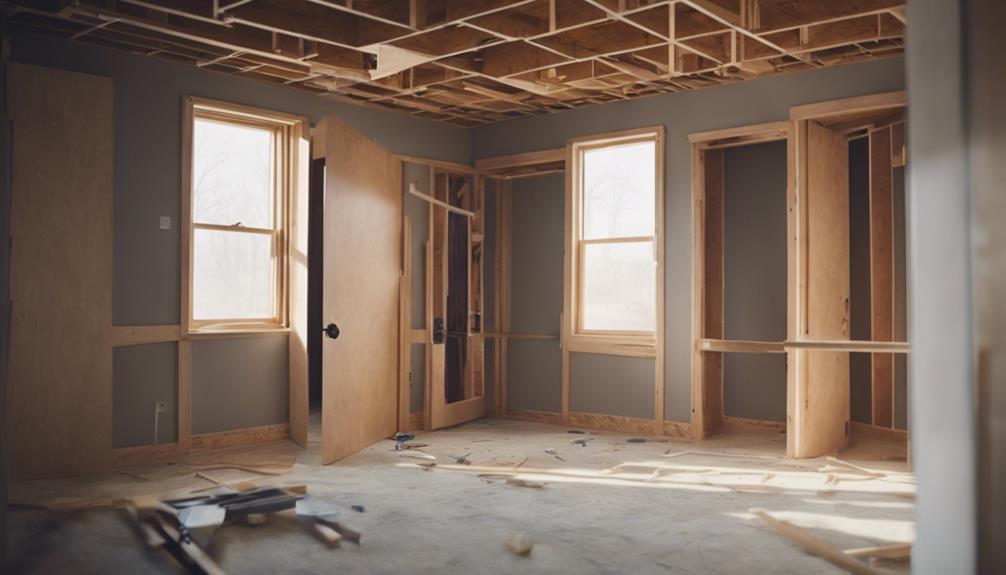
Ensuring appropriate clearances for interior doors is essential to facilitate smooth swinging motion without any obstructions. When setting clearances for interior doors, it's important to take into account the space needed for the door to function correctly. Typically, the clearance on the top of the door should be around 1/8 to 3/16 of an inch to allow for seamless operation. Adequate clearances on the latch side are also crucial to prevent any rubbing or sticking when the door is closed.
During installation, if the doors were removed while drywall was hung, adjusting the clearances may be necessary. This adjustment ensures the door can open and close without any issues. For non-drywall installations, you might need to slightly loosen screws on the brackets for proper alignment. Confirming the correct setback is important for both functionality and aesthetics. Properly set clearances not only enhance the door's performance but also contribute to the overall look and feel of the space.
Frequently Asked Questions
Do You Hang Interior Doors Before or After Drywall?
When it comes to hanging interior doors in your home, it's best to tackle this task after the drywall has been installed.
Putting up doors before drywall can result in a messy situation, with the potential for damage during finishing work.
By waiting until after the drywall is in place, you'll have an easier time aligning the door frames with the finished edges.
This method helps guarantee a clean and professional installation for your doors.
What Needs to Be Installed Before Drywall?
Before sheetrock installation, it's important to have electrical wiring, outlets, plumbing layout, and insulation in place. Coordinating with professionals for safe installation and ensuring compliance with building codes are vital steps.
Does Drywall Go Behind Door Trim?
When installing door trim, it's important to take into account whether drywall goes behind it.
Yes, drywall typically sits behind door trim to create a smooth, seamless finish. This positioning helps hide edges for a polished look.
By placing drywall before the door trim, you can easily adjust and align everything for a professional appearance.
This sequencing not only enhances aesthetics but also makes the installation process smoother.
Do You Install Pocket Door Before or After Drywall?
When installing pocket doors, it's important to do it before drywall. Placing the pocket door before drywall gives you the flexibility to adjust and guarantee proper alignment. This approach saves time and prevents potential damage.
By securing the pocket door mechanism early, you avoid complications down the road. Following this sequence ensures a smoother construction process.
Conclusion
Before sheetrock, make sure interior doors are installed to achieve flawless alignment and set clearances for a smooth finish.
With the easy hang bracket installation process, you can save time and effort.
Early door installation not only benefits the overall look of your space but also makes the process easier in the long run.
So, remember to put those doors in before the sheetrock goes up for a picture-perfect result!
